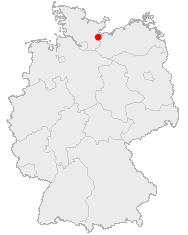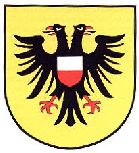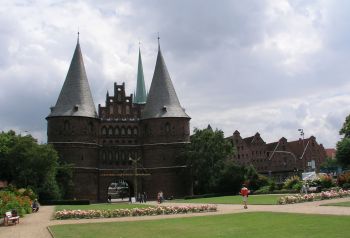| Revision as of 09:10, 12 December 2003 edit81.116.106.131 (talk)No edit summary← Previous edit | Revision as of 08:35, 29 January 2004 edit undoSnoyes (talk | contribs)12,299 edits location mapNext edit → | ||
| Line 1: | Line 1: | ||
| ⚫ | <div style="float:right;width:200px;padding-left:5px"> | ||
| ]]] ] ] | |||
| <center>]</center> | |||
| <center>''Map of Germany showing Lübeck''</center> | |||
| ⚫ | </div> | ||
| <div style="float:left;width:139px;margin-right:5px"> ] </div> | <div style="float:left;width:139px;margin-right:5px"> ] </div> | ||
| Line 9: | Line 12: | ||
| == Buildings == | == Buildings == | ||
| ⚫ | <div style="float:right; |
||
| ⚫ | ] | ||
| ⚫ | <br> | ||
| ⚫ | ''Holstentor'' | ||
| ⚫ | </div> | ||
| The old town is dominated by seven church steeples. The eldest ones are the Dom and the Marienkirche (Saint Mary), both from the ] and ]. Once the town could only be entered by passing one of four town gates, of which the ] (]) is the best known. The entire old town has kept a ] look with old buildings and narrow streets. | The old town is dominated by seven church steeples. The eldest ones are the Dom and the Marienkirche (Saint Mary), both from the ] and ]. Once the town could only be entered by passing one of four town gates, of which the ] (]) is the best known. The entire old town has kept a ] look with old buildings and narrow streets. | ||
| Line 21: | Line 19: | ||
| ] and ] were born in Lübeck. | ] and ] were born in Lübeck. | ||
| <div style="float:right;text-align:center;padding-left:20px"> | |||
| ⚫ | ] | ||
| ⚫ | <br> | ||
| ⚫ | ''Holstentor'' | ||
| </div> | |||
| Today, Lübeck is the second largest city in Schleswig-Holstein. | Today, Lübeck is the second largest city in Schleswig-Holstein. | ||
| Line 28: | Line 32: | ||
| ==External link== | ==External link== | ||
| * | * | ||
| ] | |||
| ] | |||
| ] | |||
| ] | |||
| ] | |||
Revision as of 08:35, 29 January 2004


Lübeck (population (2001): 215,330) is a city in Schleswig-Holstein, northern Germany. It was a member of the Hanseatic League and is on UNESCO's list of World Heritage Sites.
Lübeck is situated at the Trave river. The old part of the town is an island enclosed by the Trave and the Elbe-Lübeck Canal. The borough Travemünde is at the coast of the Baltic Sea.
Buildings
The old town is dominated by seven church steeples. The eldest ones are the Dom and the Marienkirche (Saint Mary), both from the 13th and 14th centuries. Once the town could only be entered by passing one of four town gates, of which the Holstentor (1478) is the best known. The entire old town has kept a medieval look with old buildings and narrow streets.
History
Originally Lübeck was inhabited by Slavic peoples, who settled at the Trave banks some kilometres outside the today town centre. They were subdued in 1158 by Henry the Lion, who newly founded the city. In the 14th century Lübeck became the "Queen of the Hanseatic League", being by far the largest and most powerful member of this medieval trade organisation, before the sister city of Danzig took over lead in the Hansa. In 1533 an armed conflict with Denmark led to the loss of the power.
Thomas Mann and Willy Brandt were born in Lübeck.
Today, Lübeck is the second largest city in Schleswig-Holstein.
To do: Lübeck laws
